ISSN ONLINE(2319-8753)PRINT(2347-6710)
ISSN ONLINE(2319-8753)PRINT(2347-6710)
Abhishek S. Tippa1, Pradeepkumar Singa2, Uday Muddapur3, Ambarish S. Sindagi4
|
| Related article at Pubmed, Scholar Google |
Visit for more related articles at International Journal of Innovative Research in Science, Engineering and Technology
In recent years the pollution of water reservoirs has become the leading environmental problem in the world. Eutrophication of water bodies is rapidly increasing due to higher sewage discharge and anthropogenic stress. Biofilm formation in lakes is due to the excessive release of chemicals such as phosphorous and nitrogen. The present study was aimed to evaluate the extent of pollution in the ancient Agasthya Lake in Badami. The investigation pertaining to chemical analysis revealed the higher amount of nitrogen and phosphorous, analysed to be 60 mg/l and 15.5 mg/l respectively. The study was conducted further to use microorganisms isolated from the above said lake for bioremediation of the same. The process deals with the identification of resistant microorganisms from the lake water and the same have been used for the degradation of chemical parameters such as nitrogen and phosphorous. For the very purpose two strains of Pseudomonas species were isolated and used for the remediation studies. Results showed a considerable decrease of the nitrogen and phosphorous contents in the lake water. The Pseudomonas species were showed the high resistant and degraded the nitrogen and phosphorus in the lake water. Pseudomonas species yielded an efficiency of more than 50% degradation of nitrogen and phosphorous Hence the study revealed that the nitrogen and phosphorous chemical parameters of the Agasthya Lake is degraded by the Pseudomonas species and are used for the remediation of the chemical parameters of the lake.
Keywords |
| Eutrophication, Remediation, Pseudomonas, Resistant microorganisms, Nitrogen, Phosphorous. |
INTRODUCTION |
| In recent years the pollution of water has become the most significant environmental problems in the world. Water is one of the essential natural resources for existence and development of life on earth. With the contamination of water, the aquatic life was also disturbed thus disrupting the whole aquatic system. Enormous anthropogenic activities make all these water resources unfit for consumption. Eutrophication of water bodies is rapidly increasing due to growing increase of anthropogenic stress, these results in the eutrophication of lakes. A biofilm is formed due to the excessive phosphorous and nitrogen content in the lake water, the layer restricts the sunlight penetrating into the water which results in the decrease of dissolved oxygen [Vasudevan et al.]. Lakes are not only a significant source of water but also provide valuable habitats to the biological world. Eutrophication and deterioration in the water quality, siltation and consequent shallowing and shrinking of lakes are the major problems and are assuming alarming proportion in India due to various anthropogenic activities. The term eutrophication can popularly be attributed to Weber(1907), who used ‘Eutrophic’ and ‘Oligotrophic’ to describe the conditions of water and soil solution. Eutrophic water is nutrient rich and oligotrophic water is nutrient poor. For undisturbed lakes eutrophication is considered by most to be a natural process, characterized by gradual filling in of the lake basin. The appearance of ‘nuisance’ algal blooms, discolouration of water, fish kills and with geological time, emergence of marsh land or swamp. Bodies of water experiencing acceleration of the natural ageing process are often said to be in a state of natural eutrophication [R. P.Vijayvergia]. One of the effective techniques being employed in the ecological rehabilitation of lakes is the application of effective microorganisms. Bioremediation is a process that uses microorganisms to breakdown substances into less toxic. In the present paper it states the technique used in the degradation of parameters such as nitrogen and phosphorous from the lake water. The objective of the study deals in Identification of the dominant and resistant microorganisms from the eutrophicated lake water, Degradation of the nitrogen and phosphorous parameters water using resistant bacteria isolated from the lake water. Studying rate of degradation of Nitrogen and Phosphorous for different months. |
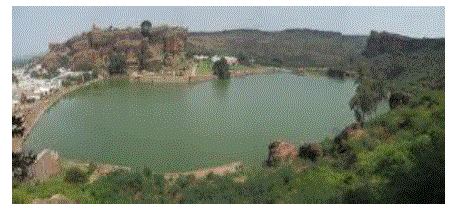 |
MATERIALS AND METHODOLOGY |
| A. Study Area: Agasthya lake is an ancient lake situated in Badami. Badami is located at Latitude: 15º55'N Longitude: 75º41'E. It has an average elevation of 586 metres (1992 feet). The temperature ranges from minimum 23°C to maximum 45°C during summer and from 15 to 29°C during winter. The rainfall of the area is 50 centimetres. It is a natural lake, three sides surrounded by rocks and one side surrounded by an embankment. Being an ancient lake ironically very less care is taken by the local bodies hence the state of the lake is in worse condition. The lake embankment was built by the Badami chalukyas, in the 5th century A.D. Though it has a great historical value, very less care was taken by the Karnataka tourism and also by the local governing bodies, which left the lake in a pathetic condition; this makes to gain attention over that lake. |
| B. Sampling: The lake water samples were collected from January 2013 to June 2013. The well cleaned plastic containers were taken for sample collection to test physico chemical parameters and sterilized borosil bottles covered with brown wrappers taken for collecting samples to test water parameters. The samples were collected between 7.00 am to 9.00am and were brought to the laboratory carefully for further analysis using standard procedures prescribed by APHA. |
| C. Isolation process: The water sample of 10 mL was mixed with 90 mL distilled water in a beaker to make solution sample. This solution sample was diluted up to 10-5 serial dilution. Serial dilution is a process of diluting a sample several times. Initially, 9 mL of distilled water was taken in each of the 5 test tubes using sterile pipettes (10 mL) with aseptic technique. By using sterile pipette (1 mL), 1 mL of solution sample was transferred into one of the 10-1 tube and mixed thoroughly. Then 1 mL of this solution was transferred to next test tube containing 9 mL of distilled and again properly mixed. |
| Nutrient agar of 25 mL is prepared, sterilized and then poured into sterile petriplate for solidification. Once the plate gets solidified, 10-5 dilution is transferred into it by using spread plate method. 0.1mL of an appropriately diluted culture is spread over the surface of agar using sterile glass spreader. The plate is then incubated at 37 ° C for 48 h. |
| D. Pure culture of bacteria: Sterilize the test tubes and prepare 25 ml of luria bertani agar, add a pinch of ampicillin (antifungal). Media was poured into sterile tubes in the inoculation chamber and was kept for solidification. Streak the culture onto the tubes and keep it for incubation at 37°C for 48 hours. Observe the colony characters after the incubation and perform the biochemical tests for the confirmation of the species. |
| E. Morphology test: Gram staining test was performed in order to identify the bacteria. |
| F. Biochemical tests: Biochemical tests are performed for the identification of the bacteria present in the lake water sample. The tests performed are catalase, oxidase, urease, citrate, total sugar iron, indole, hanging drop. |
| G. Degradation of Total Kjehldahl Nitrogen, Phosphorous: 7 conical flasks of 100 mL capacity were sterilized in an autoclave at 15 psi for 30 minutes. 100 mL of lake water sample was added to all the flasks and 10 mL of resistant bacterial culture was inoculated to all the flasks in inoculation chamber in the ratio of 10:1 and were kept in shaking incubator at 37°C for the period of 48 h. After incubation the samples were centrifuged at 3500 rpm for 30 minutes and the supernatant obtained from the centrifuged samples were analysed with respect to Total kjehldahl Nitrogen (TKN), Phosphorous, Nitrate and dissolved oxygen (according to APHA methods). |
RESULTS AND DISCUSSION |
 |
| A) Water temperature: |
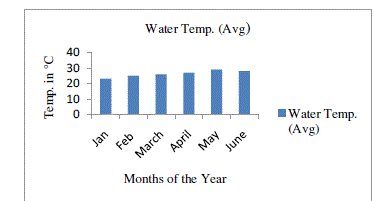 |
| As depicted in the figure 3.1 there was increase in water temperature towards the summer season, it was found out that the temperature was high in the month of May, when compared to the other months. The average temperature of all the months ranges between 23 to 28°C. During summer season the ambient temperature may rise up to 42°C. |
| B) pH: |
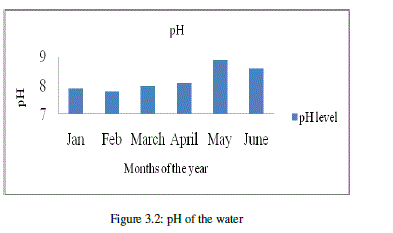 |
| From the figure 3.2 it was seen that the pH level was above the prescribed limit as per WHO standard. It was more alkaline in nature; it was observed that the pH was high during the month of May and June. The reason behind this may be the addition on the fertilizers from t he surroundings or the storm water runoff. |
| C) Dissolved Oxygen (D.O): |
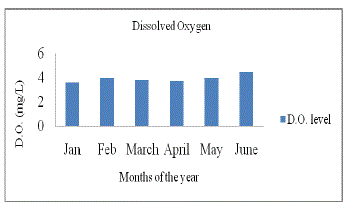 |
| It was evident from the figure 3.3 that the Dissolved oxygen. Was critical throughout the study period. The D.O. was less in the month of Jan i.e. 3.5mg/L, which is well within the prescribed limit as per WHO standards and the highest D.O. level was noted in the month of June i.e. 4.5mg/L. The reason may be the phytoplanktons or the algae that produces oxygen, hence it was observed that D.O. is around 4 mg/L. |
| D) Total Kjehldahl Nitrogen: |
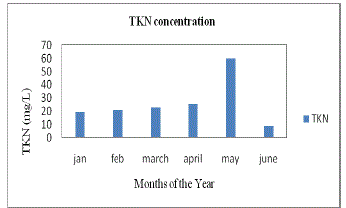 |
| As shown in the figure 3.4 TKN was not within the prescribed WHO standards throughout the study period. The TKN was very high in the month of may which exceeded till 60mg/L, due to the light showers in the month of may the agriculture run-off and anthropogenic activities contributes the increase of TKN in lake water. |
| E) Nitrate: |
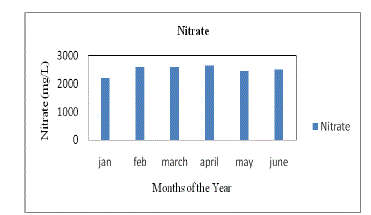 |
| As depicted in the figure 3.5 it was evident that the Nitrate value exceeds the permissible limit of the WHO standards, and it was observed throughout the study period. The value of Nitrate ranges between 2200 to 2500 mg/L, it may be due to high TKN and anthropogenic activities that takes place in the lake. |
| F) Phosphorous: |
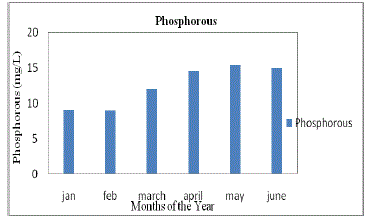 |
| As shown in the Figure 3.6 the limiting nutrient Phosphorous was not within the prescribed standards of WHO. It was high (12mg/L, 14.5mg/L, and 15.5mg/L) in the month of April, May and June, hence it can be concluded that the concentration of Phosphorous increases during summer season. The reason behind this may be the high temperature and anthropogenic activities. |
| Scenario of the Agasthya Lake: The above results were the raw water sample collected from the Agasthya Lake, Badami. The result pertaining the sample states that there was a considerable increase in the Nitrogen and Phosphorous, which results in the eutrophication. The increase in the Nitrogen and Phosphorous of the lake water, it was resulted in the formation of algal growth i.e. biofilm over the water surface. This restricts the sunlight penetrating into the part of the lake, hence decreasing the Dissolved Oxygen of the lake water. The present situation of the lake states that 90% of the lake water was deteriorated due to the anthropogenic activities of the surrounding people and the negligence of the local government. |
| Results of the Biochemical tests: |
| Morphology test: The isolated organism was gram negative bacilli. |
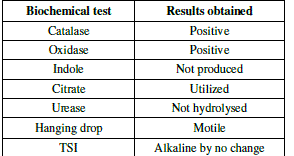 |
| The obtained results were compared with the Bergeys manual and the identified bacteria was Pseudomonas aeruginosa. Due to the pathogenecity of the Pseudomonas aeruginosa, Pseudomonas Putida was used as it is a noble bacteria. Pseudomonas Putida which shares similar characteristics with the Pseudomonas aeruginosa. The Pseudomonas Putida is used as a degrading bacteria for the eutrophicated water [Christian Weinel etal.,]. |
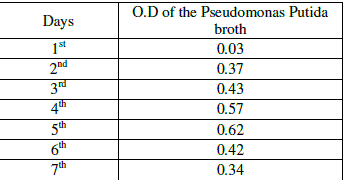 |
| G) Bacterial growth phase: |
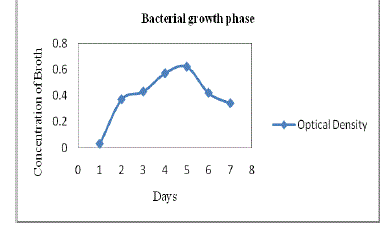 |
| Bioremediation of Nitrogen and Phosphorous: |
| Bioremediation technique was used in the degradation of the lake parameters, where the resistant Microorganisms are identified from the lake and the same was used in the degradation work. The identified resistant microorganism was found out to be Pseudomonas species bacteria. The bacteria used in the degradation work was the Pseudomonas Putida. |
 |
| H) Total Kjehldahl Nitrogen (TKN): |
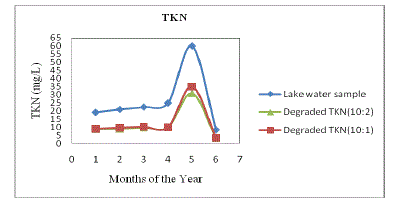 |
| As depicted in the figure 3.8 it was evident that there was decrease in the TKN of the eutrophicated water sample. It was observed that the concentration broth culture of 10:2 seen to be more efficient than the 10:1. It can be concluded that the degradation efficiency is more than 50% of both the concentration ratios. The study also reveals that the Pseudomonas Putida bacteria have efficiently degraded the TKN parameter. |
| I) Phosphorous: |
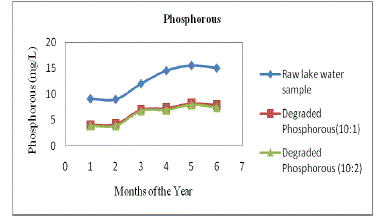 |
| It was evident from the figure 3.9 that there was considerable decrease of Phosphorous parameter with both the concentrations. The resistant bacteria used yielded a degradation efficiency of more than 50%. The broth culture 10:2 concentration shows more degradation rate than the 10:1 concentration. |
| J) Dissolved Oxygen (D.O): |
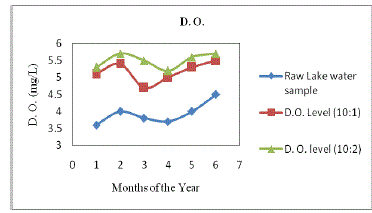 |
| As shown in the figure 3.10 there was increase in the D.O. of the eutrophicated water sample. It was subjected to the degradation of the Nitrogen and Phosphorous using the broth culture of 10:1 and 10:2 ratio concentrations, hence it can be concluded that the D.O. increased with the broth concentration. |
| K) Nitrate: |
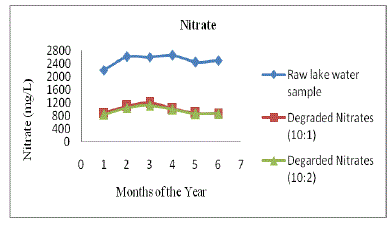 |
| The figure 3.11 shows that the Nitrate level was decreased from the initial levels. The degradation rate was more than 50%; it had increased with the increase in the broth culture. The initial level of lake water sample ranges from 2200 to 2500mg/L, and the degradation ranges from 800 to 1200mg/L. The broth concentration of 10:2 yields more degradation than 10:1 ratio concentration. |
CONCLUSIONS |
| 1. The parameters such as TKN, Phosphorous, D.O. and Nitrates exceed the permissible limits as prescribed by the WHO standards in Agasthya Lake. |
| 2. The bacterial strains isolated from the lake water, can be used for the reduction of chemical parameters of the lake water at the safer level. |
| 3. The result outcome from the study can be used for the remediation of the eutrophicated lake. |
| 4. The microbial remediation of the lake is promising in the treatment of polluted lake. |
| 5. The degradation efficiency for 10:1 concentration for nitrogen and phosphorous is 53% and 50% respectively. |
| 6. The degradation efficiency for 10:2 concentration for nitrogen and phosphorous is 63% and 52% respectively. |
| The study was carried out in the ancient Agasthya Lake, Badami for a period of 6 months. Prior to the Analysis study, site investigation was done and was found that no effluent from the industries were disposed. The analysis was carried out pertaining the Chemical parameters such as Nitrogen and Phosphorous and the analysed results had exceeded the WHO standards, which may be due to the anthropogenic stress and the negligence of the local government body. |
| Bioremediation technique was adopted in removing the chemical parameters as mentioned, where the resistant microorganism was found from the lake and was used in the remediation process. Pseudomonas species bacteria showed resistant to the eutrophicated water and Pseudomonas Putida was used in removal of excess nitrogen and phosphorous. Pseudomonas Putida degraded the parameters more than 50% of the initial levels. |
References |
|